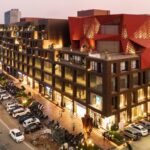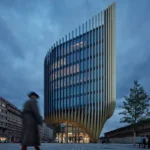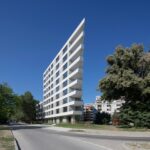Kö-Bogen Düsseldorf Building Image, Architecture Design, Architects, Kurt Zech Project News
Kö-Bogen Düsseldorf : German Architecture
Köenigsallee Boulevard Building for Stefan H. Muehling, NRW, Germany design by Architect Daniel Libeskind
20 Jun 2011
Location: Köenigsallee Boulevard, Düsseldorf, North Rhine-Westphalia, Germany
Architect: Studio Daniel Libeskind, New York, USA
Images: Rendering Rendering – Archimation
Daniel Libeskind lays the foundation stone for Kö-Bogen in Dusseldorf, Germany
Kö-Bogen Düsseldorf Building
Dusseldorf, June 17, 2011—Together with Düsseldorf’s Lord Mayor Dirk Elbers, with the investor Kurt Zech (Zech Group) and project developer Stefan H. Muehling and several hundred guests Daniel Libeskind laid the Kö-Bogen project cornerstone in a ceremony in Dusseldorf on Friday June 17th 2011.
Foundation stone laying – Grundsteinlegung Kö-Bogen, Daniel Libeskind:
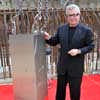
The cornerstone made of stainless steel, which was personally designed by Daniel Libeskind, will not simply disappear in to the foundation like a traditional foundation stone, instead this stone will be integrated into the facade at a very visible corner of the building, engraved with the date.
Kö-Bogen – new Düsseldorf Building:
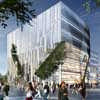
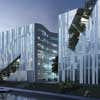
Daniel Libeskind’s Kö-Bogen project, a dynamic new office and retail complex for downtown Düsseldorf, marks an important transition between urban space and landscape. Two city blocks will be joined with one continuous roof line, forming a unified space for walking, shopping and working. The building will also create a connected space between the Schadowplatz and the Hofgarten, the central park in Düsseldorf.
The development is made up of both straight and curved geometry, its shape a reflection of the buildings and landscape around it. The straight lines are meant to reflect the city context, matching the building line on the Koenigsallee. The curved lines, which maneuver within and around the courtyards, create more fluid connections with the pedestrian environment.
Permeated cuts into Kö-Bogen itself will allow for the landscape to naturally blend and flow into the building space.The green courtyards and green roof become part of a new environment that bridges urban space with park space, a fitting entryway to and from the Hofgarten.
Kö-Bogen Düsseldorf – Building Information
Building Area: 432,300 sqft (base design) / 145,800 sqft (underground parking)
Scheduled Completion: 2013
Client: Die developer Projektentwicklung GmbH
Kö-Bogen images / information from Studio Daniel Libeskind
Previously:
Kö-Bogen
Location: Düsseldorf, North Rhine-Westphalia, Germany
Architect: Studio Daniel Libeskind, New York, USA
Kö-Bogen, currently in design, is a six-storey 432,300-square-foot office and retail complex for downtown Düsseldorf which marks an important transition between urban space and landscape.Two city blocks are joined with one continuous roof line, forming a unified space for walking, shopping and working. The building will also create a connected space between the Schadowplatz and the Hofgarten, the central park in Düsseldorf.
The building is situated along the Köenigsallee Boulevard (nicknamed Kö by the locals) and will relate in height and expression, as well as in façade design and material, to the traditionally-aligned buildings of this great urban space. With its green rooftops, Kö-Bogen will help shape the connection between the Koenigsallee and the Hofgarten, forming one continuous green space from the city center to the Tonhalle and the Rhine.
Kö-Bogen is made up of both straight and curved geometry, its shape a reflection of the buildings and landscape around it. The straight lines are meant to reflect the city context, matching the building line on the Koenigsallee. The curved lines, which maneuver within and around Kö-Bogen’s courtyards, create more fluid connections with the pedestrian environment.
Permeated cuts into Kö-Bogen itself will allow for the landscape to naturally blend and flow into the building space, connecting it further with the environment. The green courtyards and green roof become part of a new environment that bridges urban space with park space, a fitting entryway to and from the Hofgarten.
By creating a new pedestian zone, Ko-Bogen will eliminate traffic from the area and create a pedestrian connection through the city center to the building. By eliminating traffic from the Koe-Bogen, a new passageway will reach from Gustaf-Gruendgens-Platz over Schadowplatz and Corneliusplatz, all the way to the Marktplatz – a space of yet unknown quality for Düsseldorf.
The program for Kö-Bogen calls for flagship retail stores on the three lower floors and offices with business centers on the three upper floors. A two-story connecting bridge with roof terrace connects the east and west blocks of Kö-Bogen; between the two blocks are green courtyard spaces, which will also provide generous daylight to the interior offices. The passage between Schadowplatz and Hofgarten then works as a public space with benches and planters leading to a new bridge across Wallgraben.
Kö-Bogen images / information from Studio Daniel Libeskind
Kö-Bogen architects : Studio Daniel Libeskind
Location: Hofgarten Düsseldorf, Germany, western Europe
Architecture in Düsseldorf
Recent Düsseldorf Building on e-architect:
North Rhine-Westphalia capital city
Düsseldorf Airport – Flughafen: Düsseldorf International
Design: various architects, incl. JKS Perkins & Will Architects
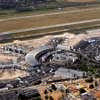
Third largest airport in Germany
New Campus FH Düsseldorf, Germany
FAR frohn&rojas
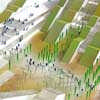
image : FAR frohn&rojas
New Campus FH Düsseldorf
Neue Zollhof office complex
Frank Gehry Architects
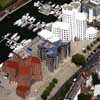
photo © webbaviation
The Stadttor
Ingenhoven Overdiek and Partners
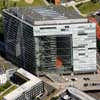
photo © webbaviation
German Architecture : Buildings
AMI Fair Stand – 2004
Caramel Architekten with fritz stiper
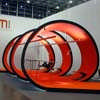
photo : caramel
Düsseldorf Fair Stand
Düsseldorf architects : Ingenhoven Architekten
Famous architect JM Olbrich died in Düsseldorf in 1908
Comments / photos for the Kö-Bogen Düsseldorf Architecture design by Architect Daniel Libeskind page welcome

